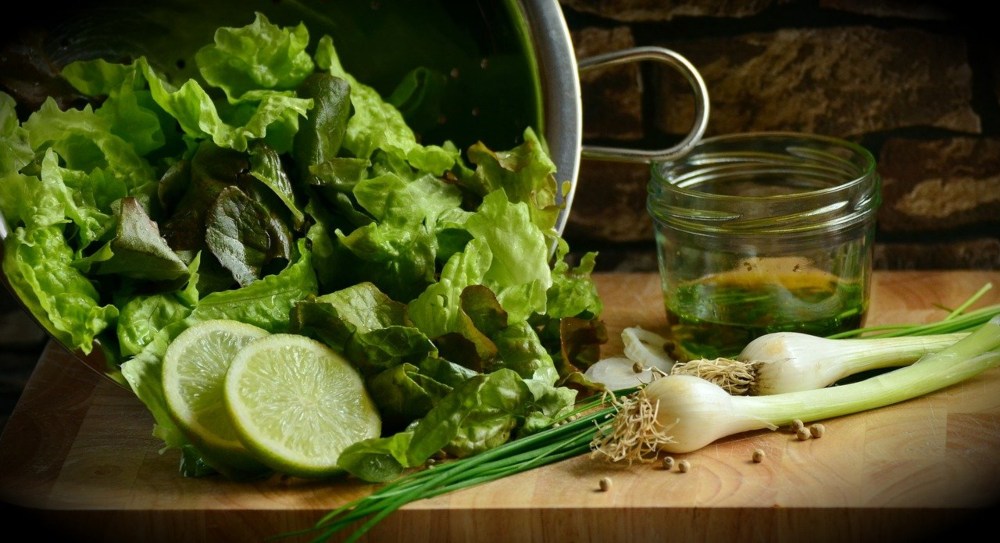
References to one’s “salad days,” it seems, began with Shakespeare when he wrote it in a line for Cleopatra who says, in reference to her romance with Julius Caesar, “My salad days when I was green in judgement…” Well might we associate salad with youth: green, vibrant, fragile but strong, and growing rapidly.
In the Northwest we can have salad and cooking greens all year round – it’s all a matter of timing. A simple 4’x8’x12” raised bed is enough for one or two people to get their greens every day. I am surprised more folks don’t do it. Yes, there is the initial labor, some expense and work on follow-through but, for me, the effort is more than compensated by not having to squander time running to the store when there is no veg for dinner. Not to mention deliciousness, freshness, and exotic custom tastes.
There are four categories for this bed: lettuces, mesclun, herbs, and cooking greens. All may cross over with the seasons and wishes of the cook, from salad bowl to steamer and back again. Lettuce, in astonishing variety: tall, short, wavy, green, purple and speckled. I like to buy my seed as a mix and transfer them to an old salt shaker, remembering that a way-too-long row will only give me way-too-much lettuce, followed in a few weeks by no lettuce at all, as I pull the plants which have left their sweet youth and become coarse and bitter. So, I measure my appetite in three-foot increments and plant only that much seed, thinning to five or six plants, harvested a few leaves at a time. Then, when the first plants are up and moving, reapply the salt shaker for the next crop.
Mesclun, French for “mixed,” arrived with more sophisticated tastes in the 70’s and 80’s when good old iceberg lost favor – and flavor – for many of us. It is sold as a varied packet mix of lively tastes and names: arugula, endive, frisee, mustard, mizuna, radicchio, and more. Like lettuces, some will come up quickly and seed out, while others, like arugula, will become tall and floppy, with edible flowers and last a year. Obviously, one has to keep an eye on things.
Herbs are an all-purpose category denying the individualities of its members. Some, like parsley, cilantro and dill, are handled like annuals. Others are small shrubs, living on in perennial glory: oregano, marjoram, tarragon. Some are relatively bigger shrubs like rosemary and sage which will not fit in the salad bed but will serve well elsewhere in the landscape.
Then there are the true eccentrics: mint and basil. Mint, in various types and flavors, wants to take over the earth. It must be confined to a container with a bit of shade and lots of moisture. Basil, royalty in the herb world, wants to believe it is living in Thailand. It craves heat and humidity and should be, for bushy, lush plants, accommodated in the greenhouse or a small palace of its own, contrived from hoops and plastic.

Cooking greens can occupy a full row in the salad bed: kale, collards, Swiss chard, bok choy and curly cabbages. This brings us to the year-round concept. In spring things germinate and grow rapidly, some go to seed, some stick around and get big. If you want to harvest in the fall and on in to winter, you must plant a second time in July.
Tall narrow lettuces winter better, and I hold off on most of the cooking greens until then. Planting in July gives them time to germinate and grow strong without bolting. Also, you can catch up with cilantro and spinach which are both absolute about counting hours of sunlight. They know, to the minute, when the summer solstice occurs and will turn production to seeds as they sense its approach. It is difficult to get a good harvest of either in the spring, and a July planting urges them on to grow vigorously and winter over.
Full disclosure here: though I speak of year-round gardening, the truth is that, like the rest of us, as the days grow truly short in late November and December, your plants slow way down, grow wan, and sleep more. They are counting on you becoming distracted by the decadent riches of the holiday season and forgetting about greens for a while. They need their leaves to make it over the hump to January, when you can feed them lightly and they can go into production way before any spring-planted newbies. There is always the supermarket – bless far-away farmers – if the cookies, fudge, liquors and roasts of the festive season leave you desperate for a box of salad mix.
Discover more from Post Alley
Subscribe to get the latest posts sent to your email.


A GREAT Sunday morning read !!